Bach and András Schiff undo time in Leipzig

Bach's music transforms, is transformed, and transforms us. These three derivatives could be summed up, like a trinity, as the thesis that has underpinned much of this year's programming at Leipzig's Bachfest, the world's most important festival dedicated to the German composer, who lived here for the last 27 years of his life. Since the opening, there have been multiple examples of these three principles being embodied, some already discussed in previous chronicles . Some proposals may not have had the ideal sonic translation, but a festival should strive to leave its mark beyond the inevitably ephemeral performances. Those who have spent these last few days in Leipzig—and people from all over the world have traveled here—will surely have seen aspects of his output illuminated that normally remain in obscurity.
Bach set himself numerous challenges throughout his life: in essence, having faced and completed one, he rarely returned to it, preferring to explore new, as yet unexplored paths. In this sense, his two volumes of The Well-Tempered Clavier are an exception, because they were also written at very different times in his biography: the first, in Cöthen, the city where he would not have minded ending his days (he confessed this with these very words to his friend Georg Erdmann in a letter dated October 28, 1730); the second, here in Leipzig, where he was undoubtedly less happy and which he would have preferred to leave—and this was the main reason that prompted him to write that letter—to find work far away. Both show us the composer immediately before and right at the end of the Lipsian period, the longest of his professional life. The first is almost the instrumental and secular counterpart of Cantatas BWV 22 and 23, which formed part of his audition for the Cantor position at the Thomasschule; the second is, in the encyclopedic and speculative vein of The Art of Fugue , the Musical Offering , or the Mass in B minor , a display of his powers and a summation of his knowledge. In both collections, complete universes are created, perfectly enclosed in themselves, inviting an eternal return, as the end returns us to the edge of the beginning. Perfect circles.

Bach's only autograph manuscript of his second book of The Well-Tempered Clavier (in whose preparation his second wife, Anna Magdalena, collaborated on at least four preludes and fugues) is in the British Library in London . The score is not complete, because three preludes and fugues are missing (in C-sharp minor, D major and F minor), easily supplemented by other copies made within the composer's circle, but it constitutes the only direct testimony that has come down to us from Bach's hand. Very far from it is its blood sister, the manuscript containing the autograph of the first book, preserved in the Staatsbibliothek in Berlin . While this is an immaculate fair copy, with a title page carefully written by the composer (and, quite possibly, containing an encrypted message), the London copy reveals the scars of its long gestation, which stretched from at least 1738 to 1742, and in which there was no shortage of revisions and corrections by the composer. Comparison with other primary sources, prepared in the musician's circle and in some cases supervised by him, corroborates the idea that the work underwent constant mutations and alterations (transformations), to the point of including significant variations in copies endorsed, at least in appearance, by its author. As is common in Bach's catalogue, both books were not published until 1801 in Bonn, more than half a century after his death.
Sir András Schiff has made Bach almost the raison d'être of his life. He has accompanied him without interruption throughout his entire professional career, and it must have been a rare day when, in public or in private, he hasn't played his music, which for him is the same "daily bread" that Chopin referred to: his greatness nourishes and overwhelms him in almost equal measure. On January 7, 2021, for example, in difficult times for everyone, he played a recital dedicated entirely to Bach's music in a deserted Wigmore Hall in London. Hence, he himself presented each of the works for the invisible audience who could follow the live streaming broadcast. And, at the very beginning, he said that "you don't have to ask me why I make a program dedicated solely to Bach, because time and again I say that, by far, the greatest composer who ever lived is Johann Sebastian Bach. That's something that doesn't need to be proven." And, before referring specifically to the first work on the program, he added with a slight smile: "Those who disagree don't have to listen to the concert."
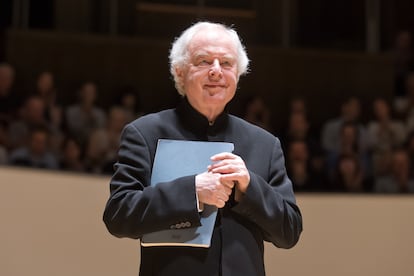
In Leipzig, he didn't address the audience—there was no need for it—because the music would confidently speak for itself, and it did. At 71, Schiff no longer played the work from memory, as he always did, to everyone's amazement. Instead, he preferred to come onto the stage armed with the Henle Verlag score (and a very discreet and effective page turner), published by Yo Tomita and featuring the Hungarian pianist's fingerings. At the end of the concert, he himself picked it up from the piano stand and left the stage just after 11 p.m., clutching it like someone guarding a precious treasure that must be preserved. At first, however, unusually for him, he didn't begin playing at his best, and it was difficult to identify him. But something changed after the very long Prelude in D major, whose two sections Schiff repeated, as Bach prescribed and as he would do throughout the concert. Then, suddenly, the pianist found himself and began to work his usual wonders.
The first wonders came immediately with the Fugues in D minor and E-flat major, a paragon of logic and voice planning, which Schiff always manages to place on the precise plane required by the music at any given moment, despite generally maintaining a very uniform dynamic and an almost imperceptible use of the sustain pedal. In the Prelude in D-sharp minor, he dared to introduce occasional embellishments in the repetitions, and in the diptych in F major, he gave a masterclass in high pulsation. The Fugue in G major was light and crystalline, and in the Prelude and Fugue in B-flat minor, a total identification between composer and performer was perhaps more evident than ever: watching Schiff while he played it gave us, in turn, the very image of happiness. The Hungarian barely introduced any pauses in the long sequence of pieces, except for a very marked one in the first part between the diptychs in D-sharp minor and E major: he, too, is human. The sensation was that of listening to an uninterrupted flow of music, moving forward guided by a higher, incontestable logic.
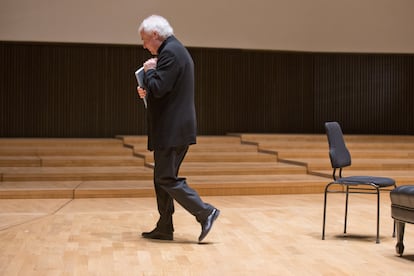
In the end, given the magnitude and persistence of the applause, Schiff decided to offer an encore. What to play after having ascended, step by step, from C major to B minor? The Hungarian opted for the only possible option: the Prelude and Fugue in B minor that closes the first book of The Well-Tempered Clavier , a nod to a new symbolic journey through the 24 stations that preceded these: Ma fin est mon commencement . According to the clock, more than three hours of recital had already passed, an objective measurement of time that clashed head-on with subjective perception: Chronos versus Kairos , as in the Cantata BWV 8 that John Eliot Gardiner had conducted days earlier. Bach and Schiff, hand in hand, had managed to dissolve time, to undo it.
But not everything has been a similar experience in recent days in Leipzig. Diego Fasolis, an incomprehensibly overrated conductor, conducted two concerts for I Barocchisti and the Swiss Radio and Television Choir (with the great Giuseppe Maletto among its members). In the former, he gave uncomfortably different treatment to two Italian members of his choir and to the two soloists (a German and an Austrian) who performed, respectively, Pergolesi's Stabat Mater and Bach's transformation into a motetto . To contrast the model and its new avatar (with a German text) is to enter his compositional workshop. But Fasolis, a conductor with very little aesthetic gestures, insists on directing everything, curtailing all naturalness. He also has absurd habits, such as leaving the sonority of the last consonant of the text suspended in the air after the music has concluded, as he did with the final n in both Amens . And in the end, he pulled out a reprise of Bach's Amen with several additional singers in the organ gallery and an oboe that didn't fit in at all with the previous performance. Things didn't improve much the following day at the Nikolaikirche, with four Bach cantatas for the Quinquagesima. The only redeeming features were once again soprano Lydia Teuscher and contralto Margot Oitzinger. Confusing texts, imbalances between orchestra and choir, a lack of fluidity, poor instrumental solos, and general boredom: little to salvage in two perfectly forgettable concerts.
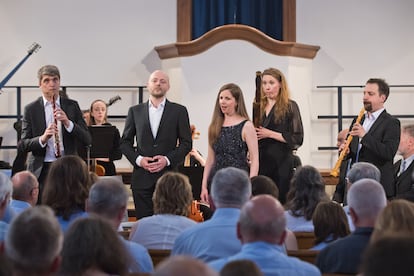
Alexander Grychtolik, also at the Nikolaikirche, ventured a guess at how a Passion-oratorio might have sounded based on a text by Picander (author of the St. Matthew Passion ), published in Leipzig in 1725, which Bach must have known. Using the same methods often employed by the composer in his parodies (such as the one based on Pergolesi's Stabat Mater ), Grychtolik uses arias and complete choruses from Bach's works, which fit Picander's new texts like a glove, in terms of their prosody and verse length. Whether or not Bach actually wrote such a composition, the problem is that Grychtolik is not a good composer and also insists on unnecessarily controlling and directing everything (even the final greetings) with a certain convolutedness: at one point, he even marked the beats of a trill by one of his soloists. There was also a mismatch between the swollen instrumental ensemble (the excellent Belgian group Il Gardellino, with Jan De Winne and Marcel Ponseele among its members) and the nine singers. Among them, Daniel Johannsen salvaged his performances with sheer enthusiasm, and Miriam Feuersinger once again showed her potential, although she seemed uncomfortable and constrained throughout. William Shelton and Tiemo Wang performed professionally, while bass Jonathan Sells struggled considerably.
This same Swiss-British singer is the artistic director of Solomon's Knot, an English group whose main peculiarity is that its singers forgo sheet music and sing everything from memory (the same is true of the obbligato instrumental parts of arias and ariosos). They also delved into the world of Bach parodies, with two funeral works (BWV 198 and 1143) for Prince Leopold of Anhalt-Cöthen (their former patron) and for the Electress Christiane Eberhardine of Saxony. The first would be parodied in the lost St. Mark Passion , while the second largely reused music from the St. Matthew Passion , premiered two years earlier. Seeing and hearing Solomon's Knot on Friday at the Evangelical Reformed Church produced contrasting sensations. It's evident how much work they've had to do to be able to perform such complex works without sheet music. However, what is actually heard fails to stir emotion, because it lacks personality and seems overly precooked and mechanical. The singers and instrumentalists (including Spanish flautist Eva Caballero) display a good overall level, although among the former, tenors Thomas Herford and, above all, David de Winter clearly stand out. Their manner inspires empathy and their effort inspires admiration, but their performances rarely surpass the threshold of correctness.
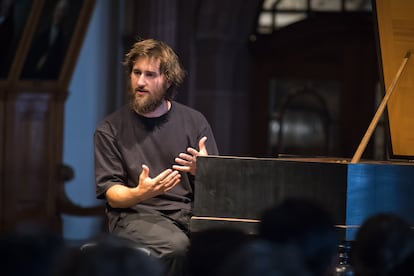
The chapter of disappointments closes with an original but poorly executed proposal. Just as Michael Maul proposed in the past a Messiah or a Ring composed from various pieces of Bach's music, David Stern and the Opera Fuoco Orchestra have created a Four Seasons with symphonies, recitatives, arias, and chorales taken from Bach's cantatas and which refer, directly or indirectly, to spring, summer, autumn, and winter. On paper, despite certain tonal clashes between pieces, the proposal is original and attractive. But neither the singers, instrumentalists, nor the conductor were able to give the idea any polish: excessive enthusiasm, tempos that were almost always uncontrolled, and, above all, very imprecise tuning and numerous misalignments.
But let's end with the many positive aspects of these past few days, among which the Gewandhaus Orchestra concert, superbly conducted by Jakub Hrůša, particularly shone. The program includes Bach's Triple Concerto, BWV 1063 (played on piano by the three first prizewinners of last March's Bach Competition); Honegger's Symphony No. 2, for string orchestra, with a concocted final chorale—an unequivocal homage to Bach—supported by a trumpet; and Brahms's Symphony No. 4, whose final movement was inspired by the chaconne-like final chorus of Cantata BWV 150, first published in 1884 ( circa 175 years after its publication!), when the Hamburg native, a loyal subscriber to the first Bach Ausgabe , was composing the work. Years later, Brahms would sing his final farewell with his Chorale Preludes for organ, another unequivocal tribute to Bach, whose portrait hung just above his bed, like a guardian angel, in his apartment on Karlsgasse.
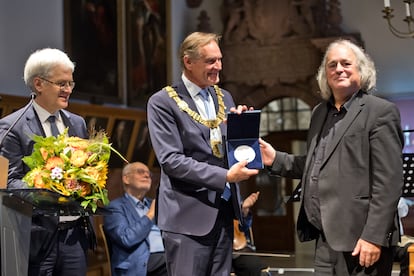
Several of this week's performances have featured two French harpsichordists: Benjamin Alard and Jean Rondeau. Their playing style is very different, as is their appearance and dress, but both are accomplished Bach musicians. The former is recording a complete set of the German's keyboard works on the Harmonia Mundi label, destined to become a reference for decades to come. His recitals at the Alte Börse (on harpsichord) and at the Sommersaal del Bach-Archiv (on pedaled harpsichord) have been paragons of sensitivity and poetry, especially the latter, performed at night for fewer than fifty people in a small hall in keeping with the evanescent, almost fugitive sound of the harpsichord. Thanks to the coupling with a second instrument equipped with pedals, we heard organ music with a sound that was completely different from usual: it didn't "fill the air," like the Salinas organ, as Fray Luis said, but, with our ears constantly on alert, the notes seemed to escape swiftly through the open windows of the Sommersaal.
The fascinating Goldberg Variations have already been discussed here. that Jean Rondeau played in Leipzig with his Nevermind Quartet. The following day, this young man with the air of a hermit (or prophet) played a solo recital at the Old Town Hall that had the fantasy of the improvising Bach as its central theme. He coincided with Alard on a work (the Toccata BWV 911) and did justice to the transformation, the guiding principle of the festival, playing pieces originally written for lute, flute (the Allemande from the Partita BWV 1013), or violin. He reserved the Ciaccona from the Partita BWV 1004 for the end, adapting Brahms's piano transcription for the left hand to the harpsichord with both hands. And, before playing it, he spoke at length about the death, day after day, of so many innocent people in the wars that ravage the world. Rondeau plays with more freedom and agogic laxity than Alard, but with the same depth and technical excellence. Off-program, he played the Aria from the so-called Goldberg Variations and then launched into the first five, without pause: transformation as the driving force of the world.
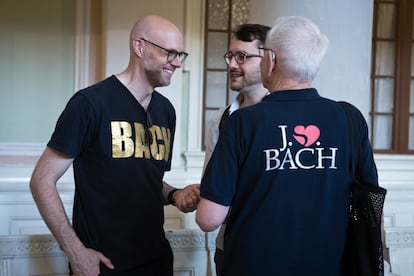
In that same historic hall of the Old Town Hall, we attended the very moving presentation of this year's Bach Medal to the great Belgian oboist Marcel Ponseele on Friday. It was preceded by a speech by the Dutch musicologist Frans de Ruiter, physically exhausted but as eloquent as ever in his laudatio . He suggested listening to some old recordings of the laureate, which sent shivers down the spines of many in the audience. The Sevillian baroque cellist Víctor García García (winner of the 2024 Bach Competition) triumphed at the Alte Börse on Saturday morning, playing and improvising like a young master. In the Paulinum on Friday evening, the female sextet Sjaella and organist Lukas Pohle presented a constant alternation of Bach chorale preludes and vocal pieces written for them by Laura Marconi and Gianluca Castelli. Just as happened at the Juan March Foundation for the inaugural concert of this season , it is hard to imagine a better put together and better performed concert, while also taking the utmost care with the purely aesthetic aspects of the staging.
Finally, on Sunday morning, several musicologists presented presentations as a tribute, on his 85th birthday, to Christoph Wolff, the current great patriarch of Bach scholarship, whose latest book has just been translated by Acantilado Publishing. Seeing him back in Leipzig, in fine form, was a perfect cap to these transformative days. Next year, Bachfest will again feature its motto, " In Dialogue ," which will once again appeal to its visitors, who have voted for their 50 favorite Bach cantatas, which will serve as the central framework for its program.
EL PAÍS





